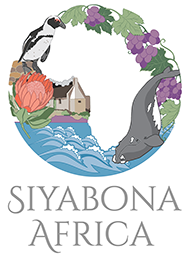
It was 1657, sent out to explore the "interior", they set up camp along the banks of the Berg River. The leader of the expedition Abraham Gabbema and his company of intrepid Dutchmen settled down for the night, uncomfortable, tired, but watchful. Then it rained during the night, adding to their misery. The next morning, when the sun rose, the massive granite domes of the mountain above them glistened like wet pearls. They named it Paarlbergh (=Pearl Mountain).
Today it still glistens when it is wet. It is still an impressive site. It makes a visit to the town of Paarl both memorable and outstanding. Paarl is recognised as the birthplace of the Afrikaans language. The soaring Afrikaans Language Monument perched on the mountain as well as the interesting museum document the pride taken in the development of Afrikaans, one of the major indigenous languages of the Western Cape. Both monument and museum are unique in that they are the only two in the world dedicated to a language.
Many of the houses along the long main street have been restored. You can see several excellent examples of Cape Dutch, Georgian and Victorian buildings, including some fine old shop fronts. There is a remarkable "Strooidakkerk" (= thatch-roofed church) on the main road. The Parsonage on the opposite side of the road serves also as a reminder that this church is the oldest still in use in the country. The original main road which passed through the town is now called Mill Street, and it too is lined with some beautifully restored houses.
Today the old mill is used as a theatre. Not far from the old mill is the site where the Cape Colony's wagon making industry was first started by Dutch and French settlers in the 17th century. The first wagons and carts imported from Germany were horse-drawn. These had to be modified to cope with the sandy soils of the Cape Flats and the rugged terrain.
Oxen obtained from local Khoisan inhabitants were found to be best suited to pulling these wagons. The 1820 Settlers and the Voortrekkers, who were pioneers in the 1830's, used ox-wagons in large numbers as people moved (trekked) into the unexplored interior, and settled in all corners of the southern part of Africa.
Later the discovery of diamonds in the Kimberley area gave impetus to this wagon-making industry. The "Gold Rush" several years later also contributed significantly to the size of this fast-growing industry. It is on record that an impressive 18 185 wagonloads of freight and passengers left for the interior in the 1850's.
Obviously a very successful business! Currently being developed is a Wagon Museum, and soon wagon rides through the historic parts of Paarl will be a highlight for visitors. The town is old, with modern developments interspersed with eye-catching older buildings. The accommodation, restaurants, wine and brandy cellars and home-craft markets are staffed by tourist-friendly locals.
Visit the well-known Paarl Gymnasium Primary School, the large church ("Toringkerk") in the centre of town - there is something to attract everyone in Paarl. However, the lovely Paarl Mountain will often catch your eye. In dry weather or wet, it is one of the finest sights in an area where the mountain views are both stunning and unforgettable!
See accommodation options Paarl Hotels
by Zola Miller
